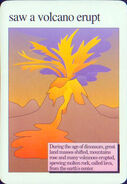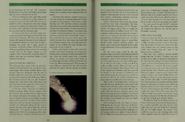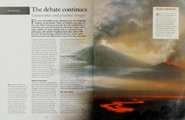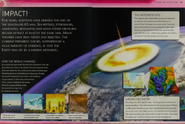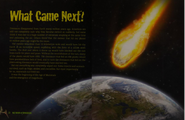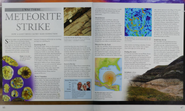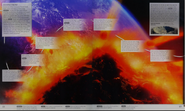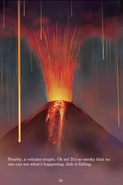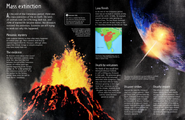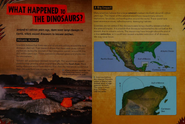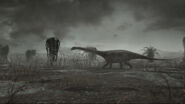See also: Cretaceous-Tertiary Transition
The Cretaceous - Teritary Extinction Event, is perhaps the most renowned of all mass Extinctions. It has been credited with the demise of the Dinosaur group (with the exception of Birds) as well as that of 75% of all species living on Earth at the time. Many have speculated as to how this cataclysmic event came underway, with theories ranging from the perfectly plausible suggestions of climate change, increased volcanic activity and meteorite impact (now proved), to the wholly ridiculous, such as alien abduction. Still others speculate how the dinosaur group may have evolved, had they not been wiped out. Projects and publications such as The New Dinosaurs and The Speculative Dinosaur Project, as well as the elusive Dinosauroid theory, all have a part to play in this prosperous branch of speculative biology. A video explaining this in close detail will be linked here.
Impact[]
66,000,000 years ago, an asteroid or comet, 10 km (6.25 miles or roughly equal to Mount Everest) in diameter, entered our atmosphere. As it entered our atmosphere, friction generated so much heat that it caught fire and it shone brighter than a million suns and burned the eyeballs of all the creatures within 3,000 km of the zone. The glow of the impactor was such that it could be seen, before and after the impact, from thousands of miles away and quite possibly within an area the size of an entire hemisphere. Its velocity (72,000 km or about 60 times the speed of sound) and mass (1 trillion tons) were so such that it took just 8 minutes for it to cross the Atlantic Ocean. It impacted at a 30-degree angle in Yucatan, Mexico, and created enough light which made flesh transparent and burned flash frames of shadows within a radius of 1000 miles. It created so much heat (about 800 degree Celsius) that boiled the water from the dinosaurs' skin and burned them. Those who were shielded by a mountain had several waves of destruction comimg for them. The impact released an energy of equivalent to 100 million megatons of T.N.T. , twenty thousand times more powerful than all the nuclear weapons ever built. It threw up trillions of boulders, about the size of a building or even a small city, but generally what goes up, must come down. Though some fragments could have reached the Earth´s escape velocity (7 miles or 11.2 kilometers per second) and even into outer space, most were pulled back by the planet´s gravity and millions of dinosaurs and flying reptiles were bombarded from above. Then came an extremely powerful earthquake, about 13 on the Richter Scale . Then came the blast wave , thrice faster than the speed of sound. It ripped skin off the flesh, and threw away the biggest dinosaurs like hay. All the creatures within 1,000 miles of Ground Zero were killed instantaneously, within 3 minutes of the impact.
Aftermath[]
Every continent suffered some of the worst effects. Even before the superquake ravaged the entire world, the impact blew away 60 million cubic metres or 3.6 trillion tonnes of Earth's surface. As a result, an ejecta cloud, i.e., a mixture of microscopic glass and particle cloud was created. It reached the Pacific southwest in just 4 minutes, and created so much heat because of friction between the particles and atmosphere, that it turned the landmasses into a living hell. It covered the entire world and it up to 500-600 degree Celsius. Forest fires caused by the heat burnt up all of the world's forests and nearly all of its vegetation. The smoke produced from them covered the entire planet, blocking sunlight for years. From the space, earth looked like an alien planet with 2 perpendicular rings around it created by ejecta. The temperature and climate changed and our world plunged into an Ice Age. All the volcanoes in the world erupted due to the seismic waves caused by the impact. Mega tsunamis, caused due to the earthquake and its aftershocks, drowned the coastlines of the world, reaching as high as 5 kilometers (3.125 miles).
All life is known to have to have been affected by this event, as shown in the fossil record, with the total exctinction of dinosaurs (besides birds), flying reptiles and many of the large marine reptiles that coincided with the dinosaurs. However, most other taxa of life persisted with some groups of animals (including sharks, turtles, crocodillians and rays) appearing less affected than others. Larger animals are known to have struggled more than smaller animals in the aftermath of this event due to the lack of food and slower reproductive cycles.
